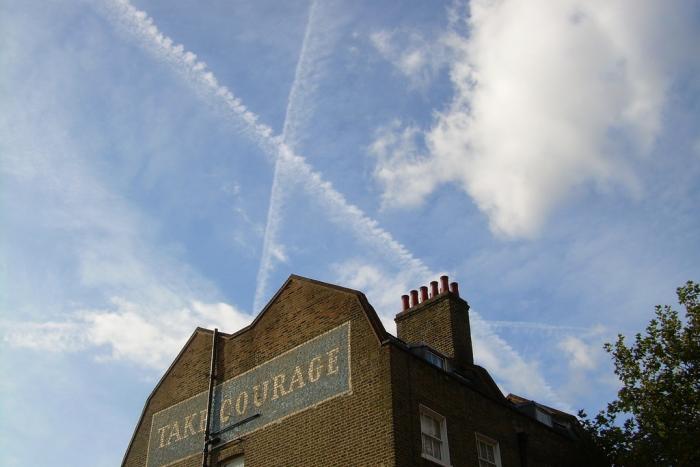Nova Scotia is a peninsula, 13,000 kilometres of rocky coastline tethered to North America by a twenty-five-kilometre strip of marshy lowlands called the Isthmus of Chignecto. Seen from above, the whole province looks like a bit of stray geographic punctuation left over at the end of the continent—if some forgetful cartographer left it out when drawing up a map, you might not even notice.
Halifax is a peninsula upon that peninsula, a metropolitan remainder dangling way out in the North Atlantic. In 2013, I moved here; in 2015, I bought a house. At the time, I thought about eastern Canada the way a lot of Canadians who are not from here probably do—that it’s a small place, at the edge of things rather than the centre, where you can live with one foot in the 21st-century maelstrom and one comfortingly outside of it. I thought about Nova Scotia the way I imagine Americans think about Maine—where the license plates, after all, bear the slogan “Vacationland.”
The house that I bought here is two-and-a-half storey tall rowhouse, built around 1920, and it exists only because of one of the world’s most famously disastrous navigation errors. On December 6, 1917, a cargo ship called the Mont Blanc, its holds swollen with a ludicrously combustible assortment of First World War-era munitions, collided with an army-supply ship called the Imo in the nearby city harbour—then one of North America’s big-deal wartime ports. The collision ignited a fire on board the Mont Blanc, which drifted north, listing and smoldering, into the narrowest part of the harbour, until it came to rest about 600 metres northwest of where my back door is today. At 9:04 a.m., with some critical threshold of temperature and pressure achieved, the ship—at that point essentially a bomb with a crew—erupted.
The explosion instantly vapourized the ship and everyone on it. It displaced enough water to expose, for a few seconds, the harbour floor, eighteen metres deep. It generated a mini-tsunami within the narrows, stripping clean the banks on either side and dragging into the churning harbour the smashed remains of houses, factories, and wharves. It destroyed a small Mi'kmaq village on the harbour’s east side—a community that persisted through more than a century at the doorstep of a colonial capital, only to be absurdly washed away in a few moments.
In a city of 60,000 people, the explosion killed about 2,000, most of them in and around the neighbourhood where I bought my famous little house. If I want, I can walk out my front door, head a block east, and climb up a steep hill there called Fort Needham Memorial Park, just recently re-landscaped in anticipation of the explosion’s 100th anniversary. There I can sit on a bench in front of a huge, angular concrete slab, split down the middle into two structures. Through the gap between the memorial’s two pillars, I can look down to the harbour below, lining up as if in a gunsight exactly where the burning ship, drifting north and pregnant with 2.9 kilotons of explosive potential, finally burst.11Actually, the view of the harbour is now partly obscured by the newly built assembly hall for the Halifax Shipyard, recently expanded to accommodate a government contract for the provision of warships.
Boom.
That’s how Halifax ended 1917: one-thirtieth of its population exterminated, and a considerable chunk of its urban landscape as mangled as any European theatre of war. The explosion was the only real violence visited on the North American mainland during either of the world’s self-titled 20th-century altercations. Until a July morning in New Mexico in 1945, it stood as probably the largest human-caused detonation in history.
But within months the ruins were cleared, and soon a new neighbourhood was being built: The Hydrostone, 324 storybook-cute little rowhouses on 10 spacious east-west blocks, fronting streets lined with newly planted baby elms and maples. And just as suburban builders in 2017 erect kitsch recreations of historic styles—Arts & Crafts, Victorian, farmhouse, neo-classical—and cram them into jarringly inapt geographies from the Florida panhandle to the Canadian prairie, the builders of the Hydrostone were happy to emulate, in a grim little garrison town at the edge of a dead empire, a mock-Tudor village in a style even then past its sell-by date.
The Hydrostone is an Anglophilic fantasy of suburbia, and the fantasia is most evident on Young Street, the main boulevard, a monumental block-long pile of superfluous dormers and chimneys all dolloped needlessly on top of one another. At Christmas, the garlands and lights and bunting along Young stretch from the yarn store to the French bakery, and limn a triangular pocket park in which sits a perfect, postcard-worthy Christmas tree. It looks like a model Christmas village, but it’s real.
What it doesn’t look like is a place where hundreds of people were incinerated, crushed, or burned alive within the reach of living memory, where windowpanes decapitated people in their living rooms, where shards of bulleting glass caused the largest mass blinding in Canadian history. The Hydrostone was an act of civic erasure, obscuring the enormity of recent tragedy beneath twee lintels and dormers. It also created a neat little paradox between what is and what was, complete with an easily resolvable tension between them, suitable for trivia and tourist brochures.
There is one thing that betrays the paradox, if you know what you’re looking for. Most of Halifax is built of wood, but within the Hydrostone’s ten blocks, every single house is built of the same hard, grey, blank-faced stone. The steeply pitched peaks and tudor-patterned stucco put a cute face on it, but they don't obscure the true origin of the neighbourhood: these are bomb shelters disguised as dollhouses.
*
When big things happen in little places, they come to define them. The explosion’s oversized place in our civic backstory is, in part, a result of how small the city still was when it happened. But Halifax was not supposed to be small. For a while, in fact—before the explosion, before the wars, before Canada—Halifax looked like it might get pretty big.
In 1860, Halifax had about 25,000 people, Toronto 40,000. The city had a real shot at becoming a northern Boston, a millions-strong metropolis encircling Bedford Basin. The essentials of that metropolis—its physicality, its lasting civic institutions, its deep history—were hardwired in this ambitious era. It was a city of rowhouses, streetcar suburbs, grand hotels, a financial district, and a globally meaningful port. Its population was, for the time, a relatively polyglot mix of Scots-Irish, Acadian, African Nova Scotian, Mi’kmaq, German, Dutch, and others.
And then, according to popular history, Canada happened. In Warden of the North, the once-seminal, now-dated, and intermittently racist history of the city first published in 1948, historian Thomas Raddall writes: “On Dominion Day, 1876—nine years after confederation—the promised Intercolonial Railway was opened for traffic from the Great Lakes to the sea at Halifax. And that was just the trouble with it. The traffic seemed to flow in that single direction by an inexorable law of gravity, like the waters of the St. Lawrence itself.”
Newly imposed tariffs between Canada and the United States massively reduced Maritime trade with nearby New England, and demand for Nova Scotia’s wooden shipbuilding fell off a cliff. Even if the reasons for the region’s downturn are complex, the simplified and popularized history holds that the new nation of Canada forced the east coast to turn away from the world and inward to a country obsessed with westward expansion.
So, 50 years after confederation, in 1917, Toronto’s population had swelled to half a million people, while Halifax had barely eked out any gains at all. Its 60,000 people still lived in a little port and garrison town, grinding out a hard living from the harbour, where they were especially susceptible to things like exploding munitions ships. The explosion could have happened in a hypothetical, larger Halifax—but it wouldn’t have been as relatively obliterating, it wouldn’t have wiped out such a huge proportion of the city’s buildings and neighbourhoods, it wouldn’t have killed one-thirtieth of the population. One hundred sixty-eight years after the city’s founding, its golden age seemingly past, the explosion was injury on top of insult.
Today, 150 years after Canada, and 100 years after the explosion, Halifax’s accidental smallness has come to seem inevitable—and in the same way, the rurality and smallness of the Maritimes and its communities is seen as eternal, a part of who we are, sometimes almost defiantly held in opposition to the bigness to be found at points west.
But if things had turned out the way we might have hoped, if we’d fared better in that new entity called Canada, that cherished smallness would have long ago given way to something bigger.
*
A paradox creates tension, and the paradox of the Maritimes—that the prosperity we longed for would inevitably have undone what today defines us—is felt nowhere more keenly than in Halifax, where the postcard ideal of the city keeps butting up against that vestigial metropolis laid out two centuries ago. Unlike the neat-and-tidy paradox of the Hydrostone, this one is unresolvable.
It might be easier to resolve if people would stop moving here, but they keep showing up, more than 8,000 in 2016, a growth rate proportionally greater than Toronto or Vancouver that year. The result is an urban building boom that this city, after decades of slow and mostly suburban growth, is totally unprepared for. Destruction and regeneration is what cities do, but Halifax’s urban churn is aimless, un-guided, damaging. The amount of historic fabric this city has lost in the past few years is staggering, and its future shape is coming together almost entirely by accident. No wonder: We can’t decide how to grow because we can’t even decide if we should grow. Haligonians are locked in a pitched battle between growth-at-all-cost boosterism and the postcard vision of smallness which we’ve never comfortably inhabited.
In the 1970s, songwriter Stan Rogers imagined himself standing at the top of our hilly downtown and casting his eyes down to the harbour, lamenting the high-rise office buildings under construction: “Upper Canadian concrete and glass down to the water line.” His complaint was that these buildings were ugly, that they were big, but most of all, not Nova Scotian. Too Toronto-y. Impostors.
But they were as much a part of Halifax as the town clock on the hill behind him, as the Victorian rowhouses, as the Hydrostone’s twee erasure of trauma, as the trauma itself. They were the latest manifestation of the international urban ideal, and we can look back and decry their ugliness and feel bad about what they replaced, but there was nothing foreign about them, just as there is nothing inherently un-Halifax about today’s tall buildings or grander civic designs, though they’re often spoken of in just those same terms, as unwelcome impostors. Mini-Toronto.
The ideal of the Maritimes—an easily knowable history, a comfortable sureness about our place in the world, even if that place is at the edge of things—lets us step outside of history, outside that maelstrom. It is comforting. It feels true. But it’s based on a collective memory that goes back only far enough to reinforce itself, and not far enough to reveal the its own falsity.
The Hydrostone is a neat encapsulation of one paradox. A fantasy of almost pastoral domesticity, it was built in response to an act of devastating violence. It was an act of civic denial. But if you know what you’re looking for, you can see it for what it is—look at those stones.
Today, as apartment towers rise along the Hydrostone’s edges, as the young move in to houses vacated by the old, as this former suburb is engulfed by the city, the city’s more intractable paradox becomes glaring. The ways in which it holds us back from realizing whatever potential we may have become more obvious. And still, the new comes to share ground with the old, and a city neither big nor small continues fumbling toward whatever it may yet be, away from what it never was.






